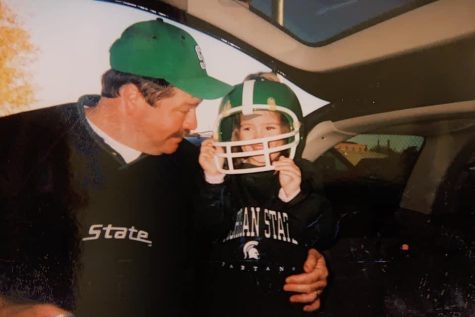My dad taught me everything I know about football; now I can return the favor
July 22, 2022

Editor’s note: This article is from the Communication Department’s award-winning Echo magazine.
My family has had season tickets to Michigan State University football games since before I was born. Our seats were always in the same place – the top of the lower half of the stadium – high up to give us a perfect view of the whole field.
Family friends had tickets behind one of the end zones. Sometimes my mom would take me down to those seats so that I could watch the cheerleaders and wave to Sparty, the team’s mascot. One day, I decided I was over the frills. I turned to my mom and said, “Can we go back to the up seats? I can see the field better up there.” Clearly my five-year-old priorities were set on football. But who could blame me? My dad made sure that I knew the game from nearly the day I was born.
My dad, Bill Covey, has dedicated years of his life to playing and coaching football, and sharing his love and knowledge of the sport with me has brought us closer. He has put in hours watching games with me, explaining the parts I didn’t understand and being impressed when I pick up on something he didn’t expect me to. To this day, my proudest moment is when I texted him during a game about a referee’s bad call, and he responded: “Good catch.”
Football has a language all its own, including different plays and lingo that will leave the average person confused. Because not everyone has had the privilege of being raised by a coach, I’ve laid out the basics of the game, minus the confusing terms. Football has brought people together since the late 1800s; perhaps it can help you bond with some of your loved ones, too.
The first thing you need to know is who’s playing. Each team is allowed 11 players on the field. The team with the ball plays offense, and the other team plays defense. On the offensive side, the key players are the center, who snaps the ball, and the quarterback, who catches the snap and either passes (which means throws) or runs the ball to get closer to the end zone.
The other nine spots are filled by guards, tackles, tight ends, running backs and wide receivers. The defensive line is made up of a combination of nose guards, tackles, backs and defensive ends. Depending on the play, the defensive coordinator will adjust how many “down guys” and linebackers there are. Down guys stay low, and linebackers stand up. Their job is to make sure the offense doesn’t get far down the field.
How a team lines up its offense can make or break their game, and the opposing team’s defense has to be ready for whatever comes. John Holecek, the head coach of the number three varsity football team in the state at Loyola Academy in suburban Wilmette, says mental strength and preparation are just as important as physical ability.
“Football is the one sport you have to study the other team beforehand, or else you’ll have no idea how to play them,” Holecek, whose team is the number three varsity team in the states, says. “So it’s a lot more intelligent than people think.”
A key concept in football is downs. The team playing offense has four tries (or downs) to move 10 yards toward their end zone. If the team succeeds, they get another four. If they don’t make it, they either lose the ball or they can punt. In a punt, a kicker from one team kicks the ball down the field to an opposing player and tries to stop them from getting close to their end zone. The key to winning is keeping control of the field.
“You punt to keep the field tilted in your direction,” my dad says. “When you punt, the other team is starting farther back. It’s all about controlling territory.”

Jacob Jaworksi is the head coach of the varsity football team at Joliet Catholic Academy, which holds multiple state titles. Looking from the outside in, Jaworski says spectators can get confused when it comes to a play being “successful” or not, because success doesn’t always mean points being scored.
“The offense is trying to create space on the field for the player with the ball, while the defense is trying to limit space,” Jaworski says. “The result of each play usually comes down to which side executes the best.”
While points aren’t the only indicators of success, they do decide the game. You’ve heard of a touchdown; here’s how it works: When the team playing offense gets the ball into their end zone, they get six points.
There are several ways to score points, but here are the most important. After a touchdown, the team can kick the ball through the uprights for one extra point or run the ball into the end zone again for two extra points. A field goal looks like an extra point kick, but it can be attempted at any time anywhere on the field, and it’s worth three points.
The winner of the game is the team with the most points on the scoreboard when the fourth quarter timer runs out. But coaches, players and fans get more from the game than wins and losses.
“I think it’s the ultimate meritocracy. It doesn’t matter where you’re from or what you look like,” Holecek says. “With the amount of different types of people, it’s really a melting pot of the sports world.”
My dad has always instilled in me the importance of being a good teammate, regardless of the team I’m on, and the discipline he passed down to me has given me a strong work ethic, ambition and perseverance.
“If one guy screws up, it affects everyone else. Football teaches you teamwork.” my dad says. “It teaches you how to get up when you get knocked on your ass and keep going.”
Jaworski describes football as a metaphor for life, and I couldn’t agree more. Look past the aggression and confusing rules, and you’ll see football is about coming together regardless of our differences. I think we can all benefit from that.
You can read the entire 2022 issue of Echo, as well as previous issues, on our website.







